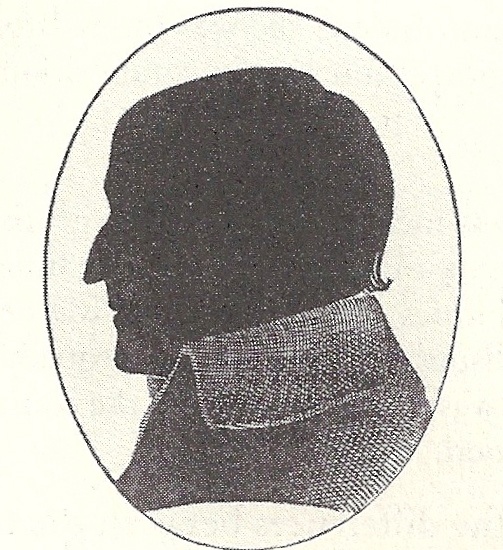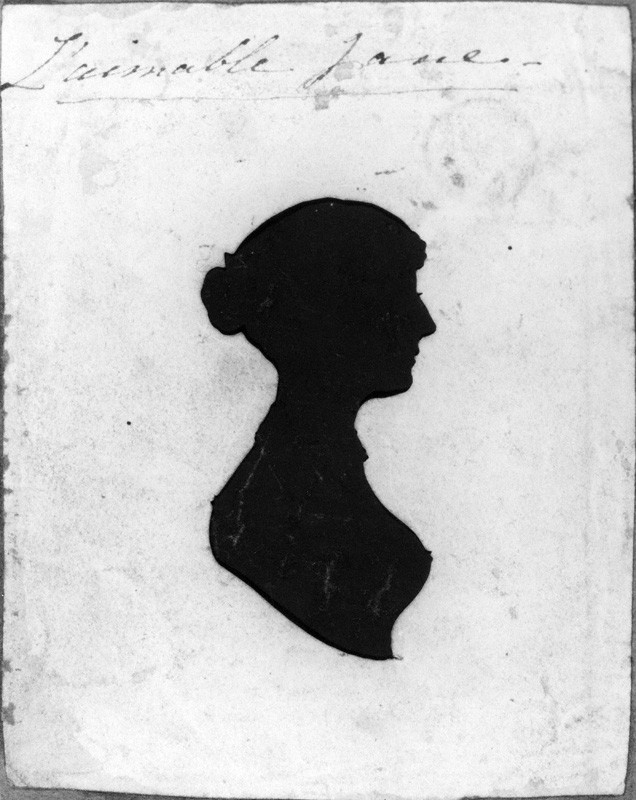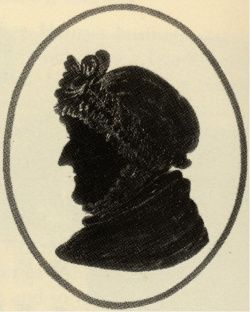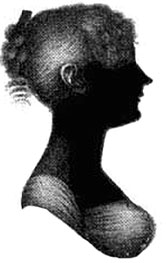This post originally appeared on the Austen Authors’ blog in April 2015. I have chosen to recycle it here. Enjoy!!!!

Jane’s father, George Austen, in silhouette
I’ve been fascinated by silhouettes since I had one done when I was a teenager by an artist at one of the tourist attractions in Tennessee. I was going down a row of souvenir shops and right in the middle of the sidewalk was a booth. As I passed, I saw that the man in the booth was using scissors to do a portrait of a woman who had stopped in front of him. I was amazed at how much it favoured her and, having a little money to spend, I had to have one. That silhouette was left in a drawer somewhere, and I thought little of it over the years, until I began reading everything I could about Jane Austen and saw some of the silhouettes of her and her family.

The famous silhouette of Jane Austen, titled L’amiable Jane, in the National Portrait Gallery in London
In the 18th and 19th centuries, the silhouette was popular with families and individuals who couldn’t afford a more formal and expensive mode of having their likenesses made. Oil paintings required several sittings, and even pastels or watercolor portraits took time. A silhouette was created in one quick sitting which made them affordable. A popular method used to create it was to have a person sit sideways before a screen with a light on a table on the other side of him. In this manner, a clear shadow was projected on the screen, which gave a perfect image if the light and sitter were arranged properly. The shadow was then replicated by hand. Among the upper class and commoners, shade parties became de rigueur, and soon almost everyone had a copy of their unique likeness. Later machines were invented for the same purpose.
Most silhouette artists were itinerants who worked their magic in popular tourist spots, such as Brighton or Bath, or at public fairs where people were apt to buy souvenirs. They either traced profiles by hand and painted them, or skillfully snipped away at paper with sharp scissors. With an experienced artist, this second method would have been fast and accurate.
The eighteenth century is widely regarded as the revival of silhouettes, though English silhouettes in those days were generally painted, not cut-out. A life-size cut-out was usually taken from the subject’s shadow, and from this, the finished silhouette was made, using a reducing instrument known as a pantograph.
The skill of the best artists lay in the painting. After painting the face solid black with soot or lamp black on plaster or glass, the hair, hats, ribbons, frills, and other essential accessories of the day would have been dragged out, using a fine brush with progressively more and more diluted pigment. Most of us are familiar with images of Jane’s distinctive profile and that of her sister Cassandra.

Jane Austen’s mother
 A complicated silhouette with painted touches, such as Cassandra’s, would take a skilled artist like John Miers a reputed three minutes to produce. With such speed, an artist working in a busy area could create enough portraits to make a decent living at a penny a likeness.
A complicated silhouette with painted touches, such as Cassandra’s, would take a skilled artist like John Miers a reputed three minutes to produce. With such speed, an artist working in a busy area could create enough portraits to make a decent living at a penny a likeness.
 A few years ago, I read an article about a book, Shades from Jane Austen by Honoria Marsh, which was published in 1975-1976 in a series of limited editions. It contains colored illustrations, mostly silhouettes, and a few reproductions of Jane Austen’s writings. Though out of print, I managed to acquire a copy for my editor for Christmas.
A few years ago, I read an article about a book, Shades from Jane Austen by Honoria Marsh, which was published in 1975-1976 in a series of limited editions. It contains colored illustrations, mostly silhouettes, and a few reproductions of Jane Austen’s writings. Though out of print, I managed to acquire a copy for my editor for Christmas.
Part one of the book includes ‘Jane Austen’s Family in Silhouette’, a table showing Jane Austen’s family and chronology of events during her lifetime (written by Peggy Hickman), and Jane Austen’s family tree. Part two includes an introduction and a discussion of Sense and Sensibility, Pride and Prejudice, Mansfield Park, Emma, Northanger Abbey and Persuasion.
I hope this has wetted your appetite to know more about silhouettes, for there is so much more information available than I could put in one post. What do you think? Are you a fan of silhouettes? Do you think the illustrations do the characters justice? I thought Mr. Darcy (above) should have looked a little heavier—more like Bingley—while Caroline’s silhouette is far too flattering. wink But that’s just my opinion. What’s yours?
Most of the information for this post came from Jane Austen’s World, https://janeaustensworld.wordpress.com/2012/10/09/shades-from-jane-austen/ and the Jane Austen Centre. http://www.janeausten.co.uk/period-lighting-and-silhouette-making/

via Silhouettes By Hand Lauren Muney cuts the silhouette of a young girl at a Renaissance event




I love revisiting this post! And I, too, like silhouettes. In fact, I’m using one on the cover for my novelette, A Merry Little Mix-up. My first introduction to silhouettes would actually be through quilting. Some of my favorite quilts are done in blues and black with black lattices serving as window pains to the silhouetted images. Very pretty. Above, I love Jane and Cassandra, but Mrs. Austen is not very flattering. Thanks for sharing. Jen Red
As we are both big Brenda Webb fans, how could I not share the post with others?
I did not know you were into quilting, Jen.